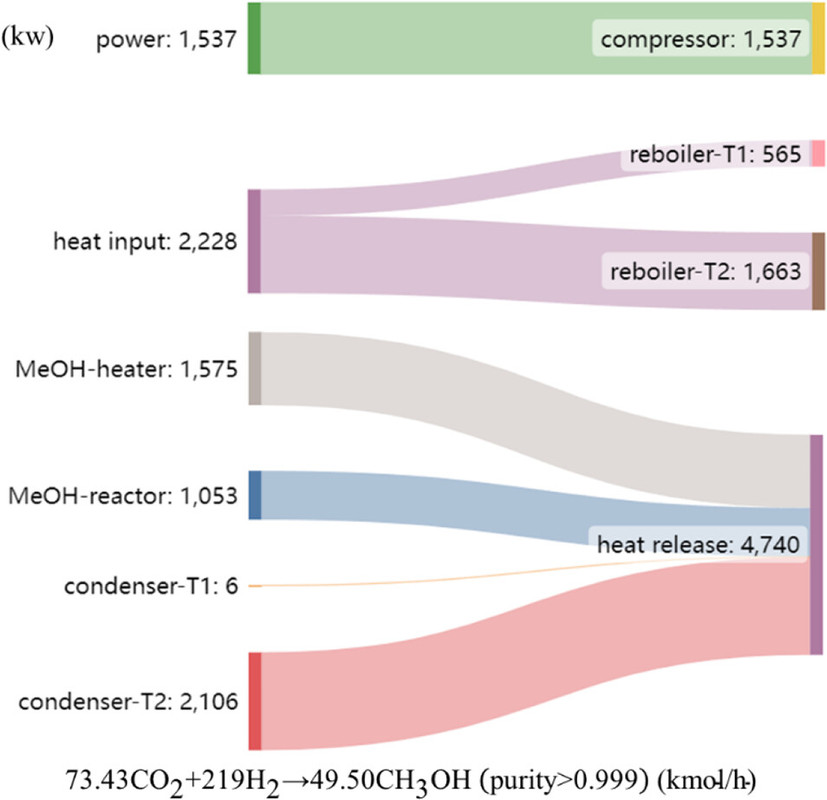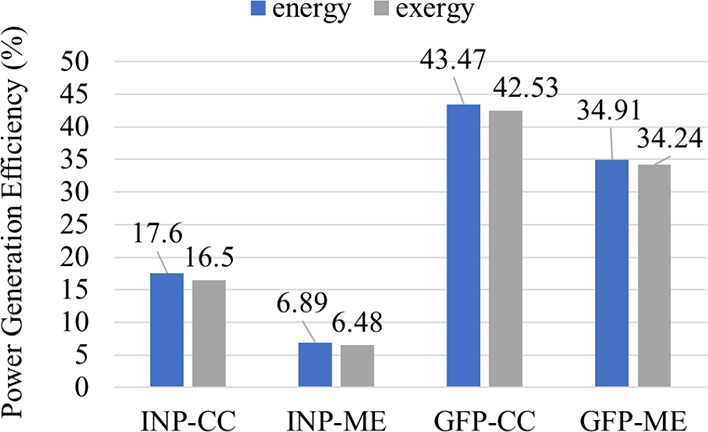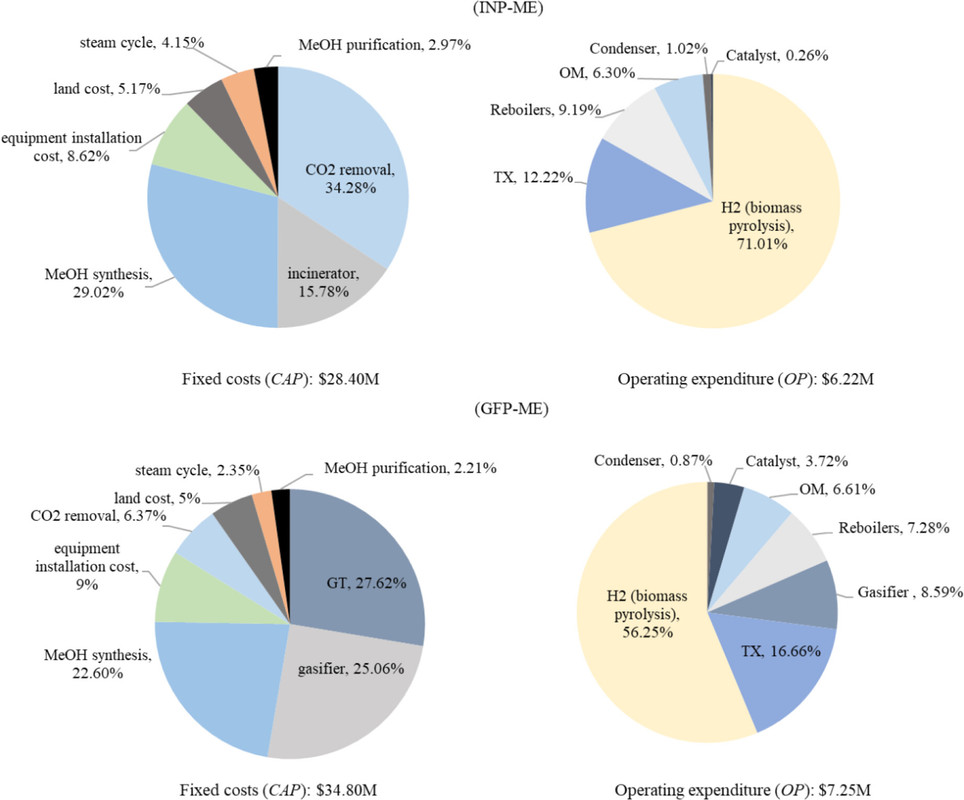Science
Related: About this forumPlastic Waste Upcycling for Generation of Power and Methanol: 3E Energy, Exergy, and Economic Analysis.
The paper I'll discuss in this post is this one: Plastic Waste Upcycling for Generation of Power and Methanol: Process Simulation and Energy–Exergy–Economic (3E) Analysis Qiming Qian, Jingzheng Ren, and Chang He Industrial & Engineering Chemistry Research 2023 62 (43), 17857-17870.
To my mind there are multiple urgent environmental disasters before humanity that bode extremely poorly for the future specifically, and the planet as a whole. None of these are even close to being addressed in my view, although personally I believe solutions do exist, not easy solutions, not cheap solutions, but solutions nonetheless. Allow me to list and enumerate a few them ordering them in my personal assessment of which are the worst and most exigent.
#1. Climate change.
#2 Plastic Pollution.
#3 Persistent Organic Pollutants, most notably flourocarbons, both in the atmosphere, water and land, and thus in the biosphere, but certainly extending to other halogenated organics and indeed, polycyclic aromatic compounds
#4 Heavy metal pollution, most notably mercury and lead, powerful neurotoxins, but also including others such as cadmium, lithium, arsenic, as well as many others.
#5 Resource depletion: The consumption of the world's best ores, the most important of these probably being one less discussed, phosphorous.
There are certainly many others and different people might order them differently than I do.
The paper cited at the outset mostly relates to #1 and #2 in my list, but certainly has implications for #3.
The introduction to the paper states the issue quite well, if clinically:
A recent report by the Organization for Economic Co-operation and Development (OECD) highlights the concerning statistics on plastic waste management. Only 9% of plastic waste is recycled, 19% is incinerated, 50% is dumped into landfills, and 22% goes into uncontrolled dumpsites. (6) Although landfill is still the predominant method of plastic waste disposal, it poses significant environmental risks, including the emission of greenhouse gases like methane and carbon dioxide, as well as threats to limited land resources and soil and water quality. (7) Consequently, alternative, sustainable recycling techniques are imperative. To address the issue of plastic waste reduction, several techniques have been proposed, which can be classified into two categories: (8) mechanical recycling and chemical recycling. Mechanical recycling requires uncontaminated waste streams and stringent sorting processes. However, most end products of mechanical recycling are down-cycled and are more expensive compared to virgin plastics. On the other hand, chemical recycling provides an opportunity to transform plastic waste into more valuable resources, offering both sustainability and economic benefits. Moreover, compared to the traditional fuels such as biomass and coal, plastic waste exhibits higher lower heating values and carbon content, indicating greater potential for energy conversion and chemical applications. The comparison of commonly used fuels and plastics is listed in Table 1...
Table 1 is of interest, and somewhat surprising with respect to the high and low heating value of high density and low density polyethylene which is actually considerably higher than coal. This is also true of mixed plastic waste, which almost certainly has a large plastic component. I argue that it is only useful to consider mixed plastic waste in most setting. The observed failure of plastic recycling, discussed with data in the introductory paragraphs above, is, in my opinion, an outgrowth of attempts to separate plastics by type.
Table 1:

The introduction continues with remarks on current thinking about how to utilize chemical recycling (currently a more or less trivial approach thus far on an industrial scale, which is not to say unworthy of discussion). Specifically it states that " industrial techniques such as incineration (9,10) with energy recovery, gasification with syngas production, (11,12) pyrolysis with oil generation, (13,−15) and hydrogenation for raw oil further refinery (16,17) have been proposed.
The purpose of this particular study is to consider the first two of these options, incineration and gasification:
1. Single power generation strategy and cogeneration scheme including power and methanol are compared.
2. Two chemical upcycling techniques, incineration and air/steam gasification, are simulated thoroughly.
3. Three assessment criteria, namely, energy, exergy, and economy, are being comprehensively studied.
4. Four processes, namely, INP-CC (direct incineration with power generation and carbon capture), GFP-CC (air and steam gasification with power generation and carbon capture), INP-ME (direct incineration with power generation, carbon capture, and methanol synthesis), and GFP-ME (air and steam gasification with power generation, carbon capture, and methanol synthesis), are developed, simulated, and compared based on the three assessment criteria.
Of the four processes listed, I will consider in this discussion of the paper only two, those involving methanol synthesis, GFP-ME and INP-ME. I am assuming that the two I will not discuss involve what is known as "CCS" which is carbon capture and storage, a nonstarter from my perspective, whereas the other two are a concept I generally support, CCU, carbon capture and utilization.
There is an issue of not throwing away the baby with the bathwater here by the way. Plastic materials play roles in modern life that would be difficult to address in any other way, and in many cases, these do involve sustainability as well important implications in human health. Hell, a Bandaid, is made of plastic. The issue of plastics in the environment, particular micro and nano plastics, will not and cannot be addressed by banning plastics, and even if that were possible, there are billion ton quantities of legacy plastics, many of those in forms that are barely visible, or not visible at all.
I am not endorsing those two processes to which I will refer, although I regard them as a very worthy "starting point" for a discussion. Whether we are aware of it or not, there are airborne nano and microplastics, and to the extent that these processes (like all combustion) involve air intake it is possible that they will be plastic negative. We should note though, that since close to 100% of plastics are made from dangerous fossil fuels, ultimately these processes as described, involve the release of carbon dioxide if methanol is used as a fuel.
However we should realize that plastics represent sequestered carbon, and methanol can be used in an industrialized process known as "MTO" "methanol to olefins" where the word "olefin" is a historic nonsystematic term still in use for the systematic name, "alkene," straight chain carbons having a double bond. In theory this process could be a closed cycle process where the carbon is "re-sequestered" as a polymer product, although this is unlikely. To the extent plastics are used as construction matrices, or multiple use products like furniture and a whole host similar products, this would amount to a small but significant economically viable form of sequestration.
An article in a subsequent issue of the journal from the issue to which the paper under discussion belongs describing approaches to MTO is here: SAPO-34 Catalyst: Synthesis Optimization by Template Alteration and In Situ Coke Evolution Analysis in Methanol Conversion to Light Olefins Mohammad Ghavipour, Ralph Al Hussami, Kirill Levin, Ranjan Roy, and Jan Kopyscinski Industrial & Engineering Chemistry Research 2023 62 (44), 18362-18378.
The title of the paper refers to (3E), "Economic, Energy, and Exergy" the latter being a thermodynamic term to which I appeal frequently as the amount of work - which in simplistic terms refers to useful energy, which can never be 100% of the energy content of any fuel, whether it's a dangerous fossil fuel, plutonium, or the common so called "renewable energy" systems. The term "exergy" is closely related to the concept of efficiency, which the airhead Amory Lovins insipidly stated would reduce the amount of energy use, since he is poorly educated and never heard of Jevons' Paradox, which has been well understood since the 19th century when it was first proposed, and which is currently being observed. Energy efficiency has risen significantly since Lovins' stupid 1976 paper, as has energy consumption. (The asinine fool is so stupid as to actually be proud of this insipid bit of bourgeois nonsense which has successfully led to the planet being in flames since our "but her emails" media declared this insufferable myopic moron a "genius." ) It would seem that despite being identified as a "physicist," he seems to be unfamiliar with the contents of an undergraduate physics course.
There should be a fourth "E" in this paper - specifically referring to "environmental" although in truth, many of the people to whom the "but her emails" media refers as "environmentalists" are anything but. For example, the German "Greens" have led an increase of the use of coal in that environmentally benighted country, and frequently Germany features the second or third highest carbon intensity for electricity after Poland, although Poland has a plan to do something about this, and Germany has no intention of addressing climate change about which, apparently, it couldn't care less:
Poland's Pomerania backs proposed nuclear plant location
For the rest of this post, I'll simply refer to the findings and results of the two methanol generating processes by appeal to a subset of the graphics in the paper.
These follow:
Process schematics for the two processes producing methanol:

The caption:

The caption:
Aspen Plus is software - I've never had access to it or used it - that is used in process modeling to calculate the external (environmental and health) and internal costs (dollars) of processes. The following graphic shows the format of inputs for a process where carbon capture is turned to carbon utilization(methanol):

The caption:

The caption:
A few Sankey type diagrams of energy and exergy flows:
Some shots for efficiency, the concept hyped by the fool Lovins without any understanding of the value and results of it:

The caption:
The efficiency of further conversion of syn gas (hydrogen and carbon dioxide) to methanol:

The caption:

The caption:
Finally the economic "E," the one so frequently abused by antinukes with their selfish and frankly appalling disinterest in providing infrastructure to future generations on their dime:

The caption:
A few comments. As a "starting point" this analysis in interesting, but some improvements both in economic terms and environmental terms are easy to spot if one considers these types of systems with nuclear inputs, particularly with respect to steam and other forms of heat the process requires. If the steam is displaced by supercritical water, I would expect significant improvements to the economic and certainly the environmental (the 4th "E" not stated) impact of the processes. In particular, this sort of approach might be addressed by flow systems in heat exchanger networks designed to improve on exergy where the heat source is clean nuclear energy, possibly resulting as a side product of supercritical water desalination which I discussed elsewhere in this space:
The Energy Required to Supply California's Water with Zero Discharge Supercritical Desalination. (One would need to address the issue of salt flows in this case, however.)
In terms of the hydrogen and air requirements, air might be replaced by oxygen generated as part of a thermochemical water splitting process run on nuclear heat, in which case the combustion becomes oxyfuel combustion and the expense and thermodynamic costs of carbon dioxide separation are avoided.
In other words, I think these kinds of systems are best if viewed as downstream utilization schemes for increasing the exergy recovered from nuclear heat, whereas, I expect the "E's" including the 4th and my view the most important "E" not covered here explicitly, environmental, advantages would exceed those described in this very interesting paper.
In terms of micro and nano plastic in our environmental matrices, these I think are best addressed by utilizing air as a working fluid in Brayton cycle type devices - air is the working fluid in jet engines which are Brayton devices - and, again, the supercritical water production from bodies of water, including but not limited to seawater. In this case, the problem of persistent organic pollutants might be addressed along with micro and nano plastic, particularly in the case where these matrices are exposed to high energy radiation in the form of gamma and x-rays.
An interesting paper, I think.
hunter
(39,677 posts)It's used to make water pipe of all sizes and as conduit and insulation for underground power and communications lines.
If we made HDPE using plastic waste and atmospheric carbon dioxide, using nuclear power as the energy source, we could build a much better world, bringing reliable electric power, clean water, and modern sanitation systems to those who now suffer without these modern necessities.
These basic necessities of modern life do not require exotic and environmentally expensive materials as are found in solar panels, wind turbines, electric cars, batteries, etc..
Clean water can be brought into every home in a plastic pipe, sewage can be conveyed to modern sewage treatment systems in plastic pipe, and electric power can be distributed through plastic insulated aluminum cables buried in the ground. Keep it simple and everyone wins.
If the manufacturing of this plastic becomes a net carbon sink, all the better.